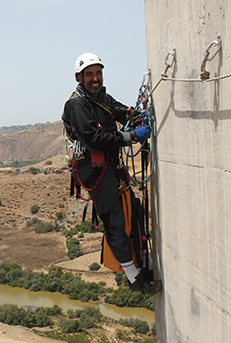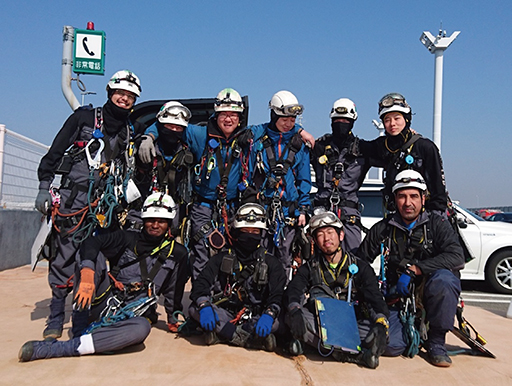Master Techniques from Japan to the World 3
Japanese-Style Maintenance and Management Techniques for Morocco’s Motorway
– Introduction of the Unique Japanese “Ninja-Tech”
25 years have passed since the opening of the motorways between the major cities in Morocco, and those motorways are relied upon by the people in Morocco as a key transport network due to their high quality. Since those motorways have such high quality, the Government of Morocco also adequately recognized the importance of not only building new motorways, but maintaining and managing existing ones. For this reason, it has been a big challenge for Morocco to introduce economical but highly reliable techniques of maintenance and management of the motorways such as road inspection.

A local engineer using Ninja-Tech to carry out an inspection on a bridge of a Moroccan motorway (Photo: Tokusyu Kousyo Gijutsu Inc.)
The Autoroutes du Maroc (ADM), which is a Morocco’s national authority for the management of motorways, established a cooperative relationship with Hanshin Expressway Company Limited in 2014. In the course of their cooperation, ADM expressed an interest in “Ninja-Tech,” the infrastructure maintenance and management technique of Tokusyu Kousyo Gijutsu Inc. (TKG) that has been successively introduced to motorways across Japan, including the Hanshin Expressway. In July 2015, ADM concluded a memorandum with Hanshin Expressway for technology exchange, and the project to transfer the technique of Ninja-Tech to Morocco started.
Ninja-Tech is a technique produced by TKG for the purpose of maintaining, managing, inspecting, and repairing infrastructure, such as high bridges and dams, or power generation facilities, which are difficult to access with traditional methods since scaffolds cannot be constructed. This method enables workers to conduct inspections and maintenance, by hanging themselves down with ropes. It is also characterized by its low cost because large scaffolding is not required and the work can be done in a shorter time.
Mr. Motohiko Nishibayashi, Manager of the International Business and Cooperation Office, Engineering Department of Hanshin Expressway, who played a central role in the project, looks back on the early days of the project as follows:
“This project to convey the technique of Ninja-Tech to Morocco progressed well. I feel that above all, this was because the people from Morocco’s ADM deeply understood that the maintenance and management of their country’s motorways would be an important step forward. The ceremony to introduce the Ninja-Tech to Morocco was attended by numerous government personnel including the Vice Minister of the country’s Ministry of Equipment, Transport and Logistics, and it was widely reported by the local mass media.”
The first thing Hanshin Expressway and TKG did for the technique transfer was to invite Moroccan engineers from ADM to Japan to undertake training, and to convey the technique to them. In 2016, as an initial trial, three engineers selected by ADM came to Japan. Mr. Takaharu Yamaguchi, Director of the Engineering Department at TKG, who was greatly involved in the training of the three engineers, recalls those days.

Japanese and Moroccan engineers who participated in the training in Japan (Photo: Tokusyu Kousyo Gijutsu Inc.)
“The three trainees went through the same rigorous training as Japanese engineers do for 60 days after arriving in Japan. Under the Ninja-Tech, engineers are required to not only move up and down using rope, but to also move by walking on the rope. To learn this technique from scratch, I believe, must have been as troublesome as a person who had never swam before, learning to swim for the first time. However, the three of them tolerated it well, and returned to their country fully equipped with the technique. They were amazingly disciplined.” Currently, the three are active as Ninja-Tech engineers, having returned to Morocco.
In this project, emphasis was placed on the establishment of the technique in Morocco in a sustainable way, as well as nurturing Moroccan engineers, going forward. Considering the success of the trainings completed in Japan, ADM will continue the training program which dispatches engineers to Japan under their own budget.
In fact, in many developing countries that hope to enhance their infrastructure in the future, such as motorways, there tends to be a focus only on “building” and a lack of interest on the importance of “maintenance and management” which inevitably come after. Mr. Nishibayashi says, “We expect that in the future, Morocco will spread this technology to the similarly-French-speaking countries of Western and Northern Africa. I also hope that expanding this project will contribute not only to the maintenance and management of infrastructure in the African region, but also to the spread of their importance.”
<< Previous Page Next Page >>
Main Text | Reference Statistics | Stories from the Field | Master Techniques from Japan to the World | ODA Topics
